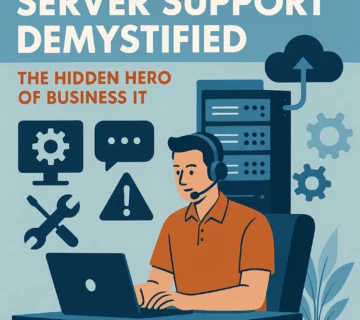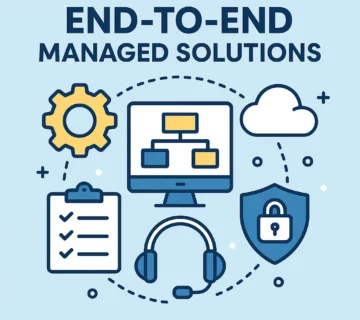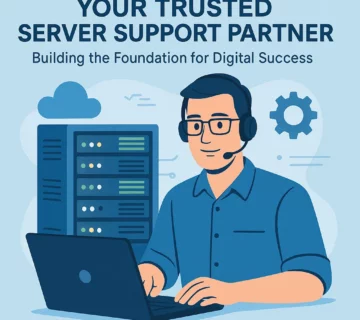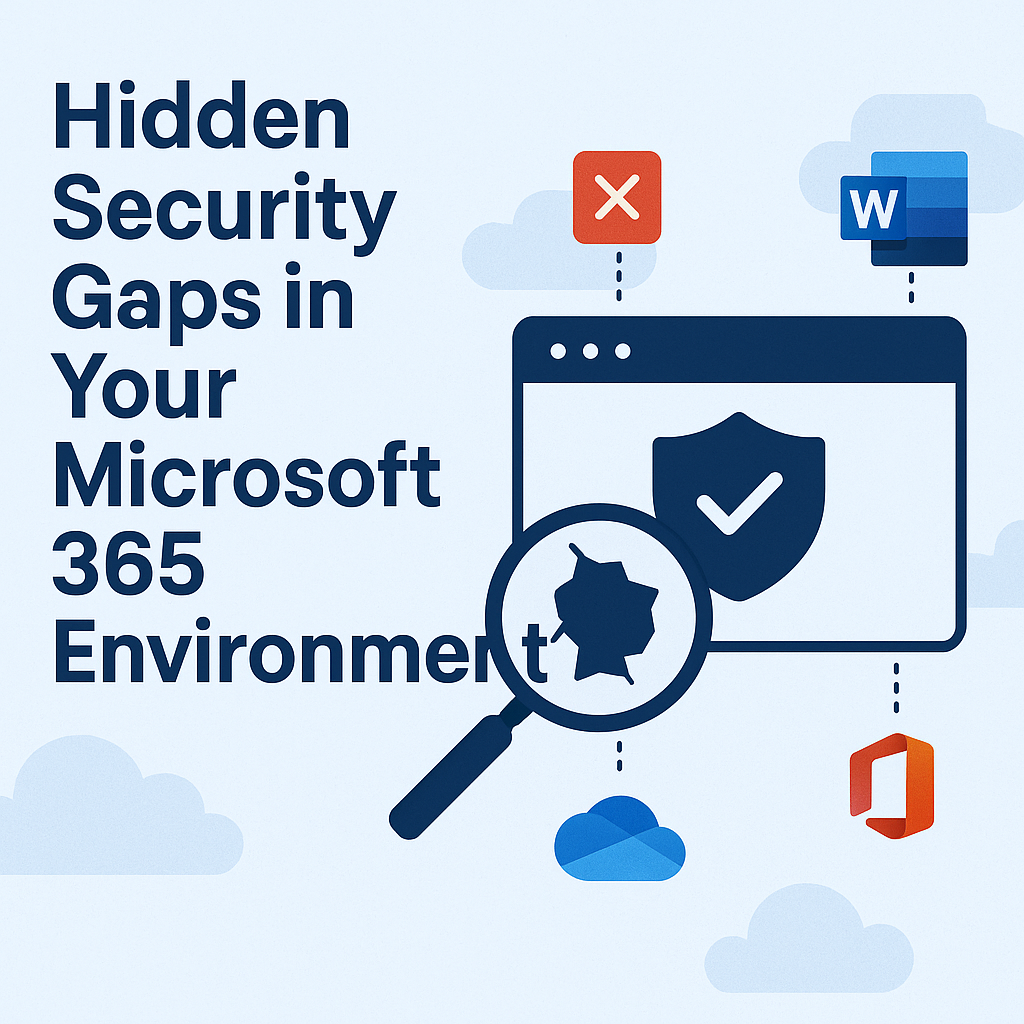Cloud vs. On-Prem: What Server Support Looks Like in 2025

The server support landscape has undergone dramatic transformation over the past few years, accelerated by remote work adoption, AI integration, and evolving security requirements. As we navigate 2025, organizations face increasingly complex decisions about where to host their infrastructure and how to support it effectively. The traditional divide between cloud and on-premises solutions has evolved into a nuanced spectrum of hybrid approaches, each demanding distinct support strategies.
The Evolution of Server Support Models
Server support in 2025 bears little resemblance to the reactive, ticket-based systems of the past decade. Modern support has become proactive, predictive, and deeply integrated with artificial intelligence. Whether your infrastructure lives in the cloud, on-premises, or spans both environments, support teams now leverage advanced monitoring, automated remediation, and predictive analytics to prevent issues before they impact business operations.
The shift toward “support as code” has fundamentally changed how organizations approach infrastructure maintenance. Support processes are now documented, version-controlled, and automated using the same principles that govern modern software development. This evolution has created new expectations for response times, resolution quality, and overall system reliability.
Cloud Server Support: The New Standard
Cloud infrastructure support has matured significantly, offering unprecedented levels of automation and intelligence. Major cloud providers now deliver support experiences that extend far beyond traditional help desk models, incorporating machine learning to predict failures, automatically scale resources, and resolve common issues without human intervention.
Proactive Monitoring and Auto-Remediation
Modern cloud support systems continuously analyze performance metrics, resource utilization, and application behavior to identify potential issues before they manifest as outages. When anomalies are detected, automated systems can adjust configurations, redistribute workloads, or spin up additional resources without requiring manual intervention. This proactive approach has reduced mean time to resolution by up to 75% compared to traditional reactive support models.
Integrated Support Ecosystems
Cloud platforms now offer comprehensive support ecosystems that include documentation, community forums, AI-powered chatbots, and direct access to specialized engineers. These systems understand the context of your specific infrastructure configuration, allowing for more targeted and relevant assistance. Support tickets automatically include relevant system logs, configuration details, and performance metrics, significantly reducing the time spent on initial diagnosis.
Scalable Expertise Access
One of the most significant advantages of cloud support is access to specialized expertise that would be prohibitively expensive to maintain in-house. Cloud providers employ experts in niche technologies, security protocols, and emerging frameworks who can be accessed as needed rather than requiring full-time employment. This model provides organizations with enterprise-level expertise at a fraction of the traditional cost.
On-Premises Support: Evolved and Resilient
While cloud adoption continues to grow, on-premises infrastructure remains critical for many organizations due to regulatory requirements, data sovereignty concerns, or specific performance needs. On-premises support has evolved to incorporate many cloud-native practices while maintaining the control and customization that drives its adoption.
Hybrid Support Models
Modern on-premises support frequently incorporates cloud-based tools and services to enhance capabilities. Organizations use cloud-hosted monitoring platforms, remote diagnostic tools, and centralized logging systems to support their on-premises infrastructure. This hybrid approach combines the control of on-premises deployment with the advanced tooling typically associated with cloud environments.
Advanced On-Site Capabilities
On-premises support in 2025 includes sophisticated local monitoring systems that rival cloud-native solutions. These systems provide real-time analytics, predictive failure analysis, and automated response capabilities. Organizations have invested heavily in local expertise and tooling to ensure their on-premises infrastructure receives support comparable to cloud services.
Vendor Partnership Evolution
Hardware vendors have transformed their support models to provide more comprehensive, proactive services. Modern on-premises support contracts include remote monitoring, predictive maintenance, and guaranteed response times that approach cloud service levels. Vendors now offer subscription-based support models that provide ongoing updates, security patches, and performance optimizations.
Comparative Analysis: Support Effectiveness
The effectiveness of server support depends heavily on organizational context, technical requirements, and resource availability. Each approach offers distinct advantages that align with different business priorities and operational models.
Response Time and Availability
Cloud support generally offers superior response times for common issues due to automated systems and round-the-clock staffing. However, complex or unique problems may require escalation through multiple support tiers. On-premises support can provide immediate physical access when needed but may be limited by local expertise and availability during off-hours.
Cost Considerations
Cloud support costs are typically included in service pricing but can become expensive for organizations requiring premium support tiers. On-premises support requires significant upfront investment in expertise and tooling but may be more cost-effective for large, stable environments over time. The total cost of ownership calculation must include not just direct support costs but also the opportunity cost of internal resource allocation.
Customization and Control
On-premises support allows for highly customized solutions tailored to specific organizational needs and compliance requirements. Cloud support, while comprehensive, operates within the constraints of standardized service offerings. Organizations with unique requirements or strict regulatory compliance needs may find on-premises support more suitable despite the additional complexity.
Emerging Trends Shaping Support in 2025
Several key trends are reshaping server support expectations and capabilities across both cloud and on-premises environments. Understanding these trends is crucial for organizations planning their infrastructure support strategies.
AI-Driven Support Automation
Artificial intelligence has moved beyond simple chatbots to provide sophisticated problem diagnosis and resolution. AI systems can now analyze complex system interactions, identify root causes of performance issues, and recommend specific remediation steps. This capability is transforming both cloud and on-premises support, reducing the need for human intervention in routine maintenance tasks.
Edge Computing Support Challenges
The proliferation of edge computing has created new support challenges that blur the lines between cloud and on-premises models. Edge deployments require support strategies that can handle distributed infrastructure with varying connectivity and local resource constraints. This has driven innovation in remote diagnostic capabilities and autonomous operation modes.
Security-First Support Approaches
Modern server support incorporates security considerations at every level, from initial system design through ongoing maintenance. Support processes now include continuous security monitoring, automated patch management, and threat response capabilities. This security-centric approach has become essential regardless of deployment model.
Making the Right Choice for Your Organization
Selecting between cloud and on-premises server support requires careful evaluation of organizational priorities, technical requirements, and resource capabilities. The decision often involves trade-offs between control and convenience, cost and capability, and standardization and customization.
Organizations should consider their regulatory environment, data sensitivity requirements, technical expertise levels, and long-term strategic goals when evaluating support models. Many successful organizations adopt hybrid approaches that leverage the strengths of both cloud and on-premises support while mitigating their respective limitations.
Assessment Framework
A structured assessment should evaluate current support effectiveness, identify gaps in capability or coverage, and project future requirements based on business growth plans. This assessment should include stakeholder input from IT operations, security teams, compliance officers, and business leaders to ensure comprehensive coverage of organizational needs.
Implementation Strategy
Successful support model transitions require careful planning, stakeholder buy-in, and phased implementation approaches. Organizations should develop clear success metrics, establish communication protocols, and plan for contingencies during transition periods. Training and change management are critical components of any support model transformation.
The Future of Server Support
Server support continues to evolve rapidly, driven by technological advancement and changing business requirements. The future promises even greater automation, improved predictive capabilities, and more seamless integration between different support models.
Organizations that invest in building flexible, scalable support strategies will be better positioned to adapt to future changes and leverage emerging technologies. The most successful approaches will likely combine the best aspects of cloud and on-premises support while remaining agile enough to incorporate new capabilities as they become available.
As we move deeper into 2025, the distinction between cloud and on-premises support will continue to blur, with hybrid models becoming the norm rather than the exception. The key to success lies not in choosing one model over another, but in developing comprehensive support strategies that align with organizational goals and can adapt to changing requirements over time.







